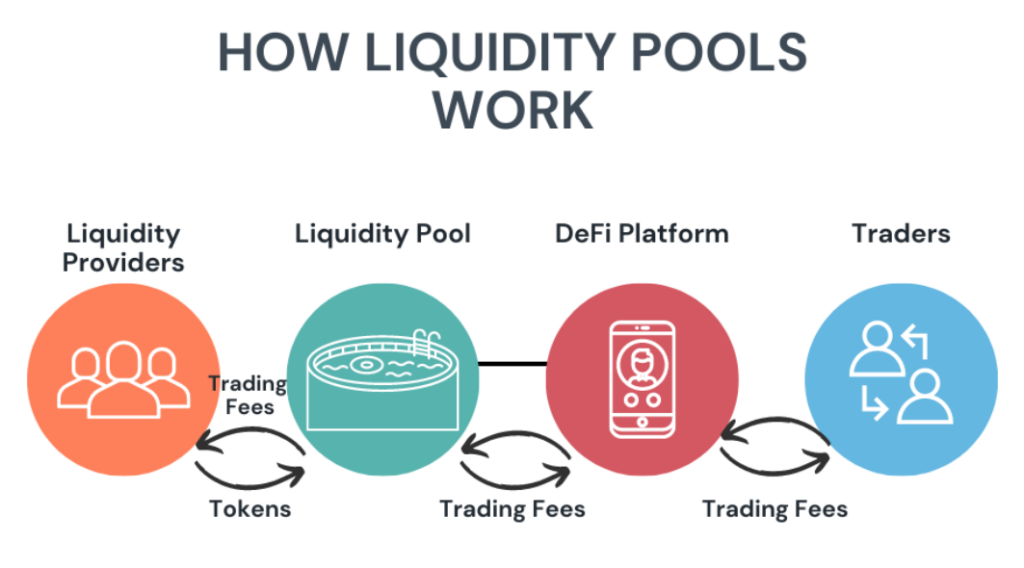TL;DR
Liquidity is essential for decentralized finance (DeFi) to function smoothly. DeFi liquidity pools enable decentralized trading by allowing users to contribute crypto assets in exchange for rewards. These pools are managed by Automated Market Makers (AMMs), ensuring efficient token swaps.
To participate, users select a DEX platform (like Uniswap or PancakeSwap), connect their crypto wallet, choose a token pair, and add liquidity to start earning. However, risks exist, including impermanent loss, smart contract vulnerabilities, and rug pulls (scams where liquidity is drained).
Without liquidity, DeFi wouldn’t exist. It eliminates middlemen, making crypto trading more accessible. To benefit safely, users should research, choose trusted platforms, and be mindful of potential risks.
Cryptocurrency has revolutionized the way we think about finance, offering a decentralized alternative to traditional banking systems. But for this new financial ecosystem to function effectively, liquidity plays a crucial role. Without liquidity, traders struggle to execute transactions smoothly, and markets become volatile.
In this article, we’ll explore why liquidity is essential, how liquidity pools work, and what risks you should be aware of before diving in.
So, what is Liquidity in Crypto?
Liquidity is a crucial factor when investing in any asset. It determines how easily you can buy or sell without drastically affecting its price.
In the world of cryptocurrency, liquidity refers to how quickly and efficiently a digital asset can be swapped for another asset or cash. Which means a highly liquid market always has buyers and sellers available, which keeps prices stable and reduces volatility.
A liquid crypto market means:
- You can buy or sell the amount you want without struggling to find a trade.
- You can execute transactions without causing huge price swings.
- There are enough buyers and sellers to keep the market moving smoothly.
What Are Liquidity Pools in DeFi?
Now that we know what liquidity is, let us take a look at what liquidity pools are and how they work.
Liquidity pools are collections of crypto funds locked in smart contracts that make decentralized trading possible. They’re the backbone of decentralized exchanges (DEXs), allowing users to trade tokens without needing a traditional market maker.
How Liquidity Pools Work
Liquidity providers (LPs) contribute assets to a pool and earn rewards in return. These rewards typically come in the form of:
- A cut of the trading fees collected by the pool.
- Liquidity provider (LP) tokens, which represent your share of the pool and can be redeemed for your original deposit plus fees earned.
How Automated Market Makers (AMMs) Help
Most liquidity pools use automated market maker (AMM) algorithms to balance prices based on supply and demand. A common method used is the constant product formula, which helps ensure fair pricing between assets.

Potential Liquidity issues in Crypto
While liquidity pools offer earning opportunities, there are some risks you should be aware of:
1. Impermanent Loss
This happens when the value of your tokens in a pool changes compared to simply holding them in your wallet. Since AMM algorithms adjust token prices automatically, you might end up with fewer assets than expected. The loss is impermanent because prices can recover over time.
2. Smart Contract Vulnerabilities
Liquidity pools rely on smart contracts, and if there’s a flaw in the code, hackers can exploit it. Some DeFi platforms have lost millions due to smart contract bugs. To minimize risks:
- Choose platforms that have been audited.
- Stick to well-known DeFi projects with strong security records.
3. Rug Pulls
A rug pull is when a fraudulent project tricks investors into providing liquidity, then suddenly removes all valuable assets, leaving LPs with worthless tokens.
How Rug Pulls Work:
- Scammers create a fake project and a liquidity pool with their own token paired to ETH or USDT.
- Investors add liquidity, thinking the project is legit.
- Scammers drain the pool, taking all the valuable tokens and leaving investors with nothing.
How to Avoid Liquidity Scams
- Stick to reputable DeFi platforms.
- Look for projects that have undergone smart contract audits.
- Avoid projects with anonymous teams or promises of unrealistic returns.
- Diversify your liquidity across different pools and platforms.
How to Use a Liquidity Pool
If you want to provide liquidity and earn passive income, here’s how you can get started:
1. Pick a Platform
Some of the most popular DEXs for liquidity pools are:
- Uniswap
- Curve Finance
- Balancer
- PancakeSwap
- SushiSwap
Each platform has its own features, fees, and governance tokens, so take time to find one that suits your needs.
2. Connect Your Crypto Wallet
Once you’ve chosen a DEX, you’ll need to link your crypto wallet. Most Ethereum-based DEXs support MetaMask, but different networks may require other wallets.
⚠ Stay Safe: Be extra careful when connecting your wallet. Scammers create fake websites that can steal your assets. Always double-check the URL before connecting.
3. Choose a Token Pair
Liquidity pools require deposits in token pairs, like ETH/USDT or LINK/USDC. Some platforms, like Balancer, even allow multi-asset liquidity pools.
You may need to deposit equal fiat values of both tokens. The platform will typically calculate how much you need.
4. Add Liquidity
- Approve the transaction and deposit your tokens.
- Receive LP tokens representing your share of the pool.
- Earn your portion of the trading fees as long as you stay in the pool.
Without liquidity, there is no DeFi. It would mean no interest in cryptocurrency and no market for people to trade. The whole point of decentralized finance is to remove middlemen and barriers to liquidity, making financial transactions more accessible and efficient. DeFi liquidity pools help make this a reality, allowing users to trade with ease while earning passive income.
However, risks like impermanent loss, smart contract vulnerabilities, and scams still exist. To make the most of DeFi liquidity, always do your research, use trusted platforms, and invest wisely. With the right approach, you can navigate DeFi liquidity pools confidently and take full advantage of their benefits.
FAQs
What is a DeFi liquidity pool?
- A DeFi liquidity pool is a smart contract that holds funds to facilitate decentralized trading, lending, and yield farming without relying on traditional market makers.
Why are liquidity pools important in DeFi?
- Liquidity pools provide seamless asset swapping, reduce slippage, enable automated market making (AMM), and improve overall liquidity in decentralized exchanges (DEXs).
How do liquidity providers earn rewards?
- Liquidity providers (LPs) deposit assets into pools and earn a share of trading fees or additional rewards in the form of governance tokens or yield farming incentives.
What are the risks of participating in liquidity pools?
- Risks include impermanent loss, smart contract vulnerabilities, rug pulls, and fluctuating market conditions that may impact returns.
How do liquidity pools impact the growth of DeFi?
- Liquidity pools enhance the efficiency of decentralized finance by enabling permissionless trading, improving price stability, and fostering a more accessible and decentralized financial ecosystem.








